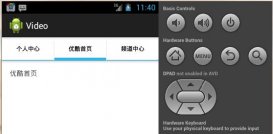本文实例讲述了Android使用Jsoup解析Html表格的方法。分享给大家供大家参考,具体如下:
看代码吧,可解析表中的label text button 自己根据需要再添加,呵呵
|
1
2
3
4
5
6
7
8
9
10
11
12
13
14
15
16
17
18
19
20
21
22
23
24
25
26
27
28
29
30
31
32
33
34
35
36
37
38
39
40
41
42
43
44
45
46
47
48
49
50
51
52
53
54
55
56
57
58
59
60
61
62
63
64
65
66
67
68
69
70
71
72
73
74
75
76
77
78
79
80
81
82
83
|
import java.util.ArrayList;import java.util.List;import org.apache.http.NameValuePair;import org.apache.http.message.BasicNameValuePair;import org.jsoup.Jsoup;import org.jsoup.nodes.Document;import org.jsoup.nodes.Element;import org.jsoup.select.Elements;import android.app.Activity;import android.graphics.Color;import android.os.Bundle;import android.view.View;import android.view.ViewGroup;import android.view.Window;import android.view.View.OnClickListener;import android.widget.Button;import android.widget.EditText;import android.widget.TableLayout;import android.widget.TableRow;import android.widget.TextView;import android.widget.Toast;public class TableParseActivity extends Activity{ private Document doc; private String html = null; private TableLayout tableLayout; private final int WC = ViewGroup.LayoutParams.WRAP_CONTENT; private final int FP = ViewGroup.LayoutParams.FILL_PARENT; private final int WIDTH = 80; private String functionName,fields; private List<NameValuePair> params; private static String url; @Override public void onCreate(Bundle savedInstanceState) { super.onCreate(savedInstanceState); setContentView(R.layout.analyzing); html = "需要解析的HTML字符串"; tableParse(); } public void tableParse(){ doc = Jsoup.parse(html); Elements trs = doc.select("tr"); tableLayout = (TableLayout)findViewById(R.id.tableLayout1); TableLayout.LayoutParams p = new TableLayout.LayoutParams(FP, WC); this.setTitle(doc.title()); for (Element row : trs) {//循环表下的行 tr对象 TableRow tableRow = new TableRow(this); Elements cols = row.children(); for (Element col : cols) {//循环行下的列 td对象 Elements children = col.children(); for (Element child : children) { if(child.tagName().equals("label")){ TextView textView = new TextView(this); textView.setText(child.val()); textView.setTextColor(Color.BLACK); tableRow.addView(textView); }else if(child.tagName().equals("input")&&child.attributes().get("type").equals("text")){ EditText editText = new EditText(this); editText.setText(child.val()); editText.setWidth(WIDTH); tableRow.addView(editText); String id = child.attributes().get("id"); if(id.length() > 0){ editText.setId(Integer.parseInt(child.attributes().get("id"))); } }else if(child.tagName().equals("input")&&child.attributes().get("type").equals("button")){ Button button = new Button(this); button.setText(child.val()); tableRow.addView(button); fields = child.attributes().get("fields"); functionName = child.attributes().get("functionName"); button.setOnClickListener(new OnClickListener() { @Override public void onClick(View v) { //TODO onClick } }); }//end if(child.tagName().equals("input")&&child.attributes().get("type").equals("button")) }//end for (Element child : children) }//end for (Element col : cols) tableLayout.addView(tableRow,p); }//end for (Element row : rows) }//end tableParse()} |
希望本文所述对大家Android程序设计有所帮助。














